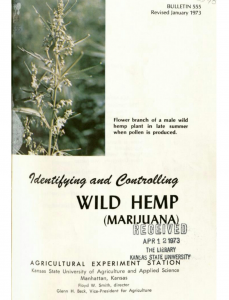It’s common knowledge that government agencies and private companies influenced the prohibition of cannabis and industrial hemp. However, something many do not know is hemp was studied at great length in agriculturally-centric states such as Kansas. What better location to research crops than one of the largest remaining prairie ecosystems in the world?
Ironically, as one of the last places to abolish its prohibition, what ultimately matters most was who funded and guided those studies. Historical information I recently uncovered shows that institutional proof exists about the importance of industrial hemp, and why its reintroduction is crucial for a number of reasons.
Farmers care deeply about the environment, and decisions are based on markets, therefore understanding these lessons of our past are more important now than ever. For decades, America’s Heartland was a large contributor to the hemp industry. In fact, according to a state agriculture report, Kansas even ranked first in the U.S. for bushels per acre in 1863. When I was young, my father told me he participated in a project studying eradication methods of hemp in Riley County while earning his biology degree at Kansas State University during the 1970s. After searching for the report on and off for years, I finally found the work my father participated in, along with two others, in September 2017.
While citations can be found on the internet, full versions are restricted except by going through thousand-dollar paywalls requiring login information. After a challenging process, complete with archivists looking through original documents in a vault and sending them electronically, within a couple weeks I had one of the only (if not the first) digitized copies of “Identifying and Controlling Wild Hemp (Marijuana).”

What I found was that the reports helped legitimize the “war on drugs,” which led to the incarceration of millions of people, in addition to the use of taxpayer dollars for entering farmers’ lands to eradicate a plant. These efforts however, were not based on thoroughly vetted evidence. When looking closely, the research projects were funded by and benefited a crop protection and pharmaceutical manufacturer. The authors also gave acknowledgements to the state’s Marijuana Control Steering Committee. Plus the works originated from and referenced medical research, even though the intended purpose was ag-based.
Much of the wording reflected what the aforementioned influencers wanted to categorize the plants as: a single, weed-causing infestation that had to be eliminated (since they believed embracing it would impact their profits as well as industries such as cotton and wood paper). These conflicts of interest can no longer be ignored by environmentally conscious, farming communities: One of the most important and damaging of all findings claims a farmer could either practice deep plowing — which we know to be economically inefficient and damaging to soil health — or farmers could use chemical products “without disturbance of the soil profile.” A final and crucial finding admits the varieties of cannabis that grow throughout Kansas are not only low in potency, but they do not fluctuate in cannabinoid content. This means authorities knew at the time of its ratification there was not an objective or scientific justification to outlaw hemp based on the sole argument that it was thought to be a drug.

Thanks to modern genetics, it is becoming more commonly accepted that cannabis cultivated for medicinal purposes cannot be grown anywhere near industrial hemp, since cross-pollination is proven to always result in decreased potency. Variations between fiber and “drug” types come in many forms, ranging from physical appearance and time of harvest, to expression of certain traits. Taking into account limitations during the early years of cannabis research and biases, this data allows us to rediscover the importance of scientific integrity. Together we have the collective responsibility to identify and accept inconsistencies we find, and prevent the suppression of information that does not result in beneficial policies for our citizens or environment.
Farmers know industrial hemp grows well in many climates and requires fewer overall resources compared to other commodities like corn and soybean. Even as a rotational option to improve successive yields of other crops, hemp is proven to help in multiple aspects. Its cultivation promotes ways of regenerative and sustainable agriculture that are desperately needed, especially in places like Kansas, where irrigation has taken its toll. Simultaneously, our soil and ecosystems need remediation. Through embracing modern science to reduce harm and improve our environment, farmers are in a unique position to right the wrongs of the past and help limit unfounded restrictions that hold back progress among all populations.
An extended version of this article first appeared here on Medium.com.


